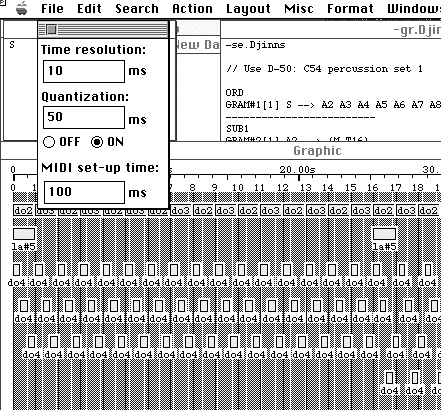Victor
Hugo against Darius Milhaud
You
will appreciate BP2's ability to produce intricate
polyrhythmic
patterns
by playing item produced by "-gr.Djinn
s"
with percussive sounds (e.g. Roland's "C-54 percussion set 1"). The piece was
created to synchronise the recitation of Victor Hugo's poem "
Les
Djinns
"
with the opening section of "
La
Création du Monde
"
by Darius Milhaud (EMI CDC-7 47845 2) in Andréine Bel's choreographic
work for
Collège
des Prêcheurs
and
Conservatoire
Darius Milhaud
(Aix-en-Provence, 1992). We found that the meaning of the poem would coincide
with particular events in the musical piece. Then we calculated a time-base
value fitting the two tracks together: setting 1000 beats in exactly 1578
seconds was possible since BP2 does not round integer ratios.
Poem
"
Les
Djinns
"
is built on verses with variable meters: 2/2/2/2/3/3/3/3/4/4/4/4 ...up to
10/10/10/10 --except 9/9/9/9-- and then decreasing (see appendix).
We
decided that every verse should have the same duration marked by 16 beats with
a stronger first beat. The result is a polyrhythmic piece with one instrument
showing beats at a fixed speed and another one playing ticks at variable
speeds. Listening to variable parts made it possible for children to recite
the poem at the expected tempi.
The
grammar below shows how the piece was produced. It has 15 sections labelled
"A2", "A3", etc. Each section puts together a fixed motive "M" and a variable
motive "T16", "T24", etc. Here, "T16" stands for 16 ticks played as note
"do4". Fixed motive "M" is a string of alternated "do2" and "do3" with a
stronger beat in the beginning, where "sib5" is played together with "do2".
-se.Djinns
ORD
S
--> A2 A3 A4 A5 A6 A7 A8 A10 A8 A7 A6 A5 A4 A3 A2
-------------------------
SUB1
A2
--> {M,T16}
A3
--> {M,T24}
A4
--> {M,T32}
A5
--> {M,T40}
A6
--> {M,T48}
A7
--> {M,T56}
A8
--> {M,T64}
A10
--> {M,T80}
-------------------------
ORD
T16
--> T8 T8
T24
--> T16 T8
T32
--> T16 T16
T40
--> T32 T8
T48
--> T32 T16
T56
--> T48 T8
T64
--> T32 T32
T80
--> T40 T40
T8
--> Tik Tik Tik Tik Tik Tik Tik Tik
-------------------------
SUB1
M
--> {1,do2,sib5} do3 do2 do3 do2 do3 do2 do3 do2 do3 do2 do3 do2 do3 do2 do3
Tik
--> do4
Fig.21
A grammar for reciting poem "Les Djinns"
Below
is a graphic example of the output of "A6 A7".
Fig.22
The "A6 A7" tick pattern in "Les Djinns"
If
only variable parts must be heard then regular beats "do2" and "do3" may be
replaced with silences.
It
is easy to figure out that the full piece would require an excessively large
phase diagra
m
(more than 200,000 columns) because it is based on the lowest common multiple
of 2, 3, 4, ... 10. Therefore it can played only if
quantization
is set to a reasonable value (see §6 of reference manual). We found that
musicians were be satisfied with a 50 millisecond quantization even though
deviations of ±50ms were still noticeable in the "A7" part. With this
setting, computation requires a 2 Mbyte memory partition for BP2 and it takes a
couple of minutes on a Mac IIci, so be patient if you can't borrow your rich
neighbour's PowerMac...
You
may use almost the same grammar with syllabi of the poem stored on a sampler
and triggered by appropriate keys. I prefer live children's voices...

